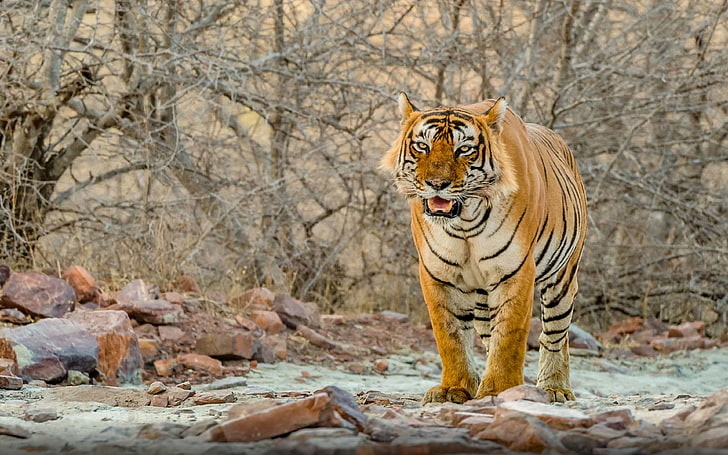
Ranthambore Tiger Safari’s Golden Triangle Tour Offers the Ideal Combination of History and Wildlife
One of the most well-liked travel routes in India is the Golden Triangle tour, which includes Ranthambore Tiger Safari’s Golden Triangle Tour Delhi, Agra, and Jaipur and offers a fascinating fusion of historical sites and cultural encounters. However, why not combine the two into an exhilarating wildlife experience for a novel twist? The thrill of seeing Bengal tigers in their own habitat is combined with the greatest of India’s cultural history on the Golden Triangle Tour offered by Ranthambore Tiger Safari. Everything you require to know about this enlightening voyage will be covered by this guide.
An outline of the Golden Triangle Tour
What does the Golden Triangle entail?
Three important Indian towns are connected by the well-known Golden Triangle: Delhi, Agra, and Jaipur. For those who wish to quickly feel the spirit of India, the triangle-shaped tour highlights some of the most famous sites in the nation.
Important Places to Visit: Jaipur, Agra, and Delhi
Delhi: The nation’s capital, where the ancient and the new coexist, is home to important historical sites including the India Gate, Qutub Minar, and Red Fort.
Agra is home to the Taj Mahal, one of the Seven Wonders of the World, as well as other popular tourist destinations like Fatehpur Sikri and the Agra Fort.
Jaipur: Also referred to as the “Pink City,” Jaipur is well-known for the Hawa Mahal, royal palaces, and forts like Amer Fort.
Why Include a Tiger Safari at Ranthambore on Your Golden Triangle Tour?
The Excitement of Observing Wild Tigers
One of India’s best locations to witness Bengal tigers in the wild is the state of Rajasthan’s Ranthambore National Park. A Ranthambore safari is the ideal way to combine exciting wildlife encounters with cultural insight on your Golden Triangle tour.
An Original Touch for Your Cultural Tour
A Ranthambore Tiger Safari adds a fresh level of adventure and wildlife, whereas the Golden Triangle is primarily focused on history, architecture, and culture. In contrast to the busy metropolises of Delhi, Agra, and Jaipur, it provides a welcome change of pace.
Departing Delhi to Begin Your Golden Triangle Tour
Investigating Delhi’s Historical Monuments
The Golden Triangle tour frequently begins in Delhi. This energetic city offers a blend of historical and contemporary sites. Start your trip by seeing some of Delhi’s most well-known landmarks.
Important Locations: Red Fort, Qutub Minar, and India Gate. India Gate is a military memorial erected in memory of Indian soldiers.
Red Fort: A masterpiece of Mughal architecture and a UNESCO World Heritage site.
The tallest brick minaret in the world, Qutub Minar is encircled by historic sites.
Chandni Chowk and Jama Masjid in Old Delhi
A peek of the rich history and culture of the city may be found in Old Delhi. See one of the biggest mosques in India, Jama Masjid, then take a leisurely stroll through Chandni Chowk, a lively marketplace brimming with regional cuisine and souvenirs.
Next on the itinerary: Agra, home of the Taj Mahal
Taking in the Majesty of the Taj Mahal
The Taj Mahal is without a doubt the tour’s high point on any Golden Triangle itinerary. One of the most popular tourist destinations in the world, this white marble monument was constructed by Emperor Shah Jahan in honor of his wife Mumtaz Mahal. It is a symbol of unending love.
Seeing Fatehpur Sikri and the Agra Fort
Agra is home to several important historical landmarks besides the Taj Mahal, such as the large red sandstone fort known as the Agra Fort and the abandoned city of Fatehpur Sikri, which has breathtaking Mughal architecture.
Agra’s Regional Cuisine and Culture
Don’t pass up the chance to sample the rich and tasty Mughlai food while in Agra, which is noted for its biryani, kebabs, and the well-known sweet petha.
Jaipur, often known as the “Pink City” of Rajasthan, is home to the Amer Fort, City Palace, and Hawa Mahal.
The state capital of Rajasthan, Jaipur, is home to numerous architectural marvels. See the magnificent Hawa Mahal, sometimes called the Palace of Winds, the imperial City Palace, and the imposing Amer Fort.
The Bright marketplaces and Handicrafts of Jaipur Known for its vibrant marketplaces that sell traditional Rajasthani handicrafts, jewelry, textiles, and pottery, Jaipur is also a shopping haven.
Travel to the National Park of Ranthambore
Expectations for the Journey from Jaipur to Ranthambore
By car, the trip from Jaipur to Ranthambore takes three to four hours. A view of the rural Rajasthani environment and hamlet life is provided by the picturesque drive.
Sawai Madhopur Arrival: The Entryway to Ranthambore
The settlement closest to Ranthambore National Park is Sawai Madhopur. Before starting their tiger safari, the majority of tourists stay here in one of the numerous hotels or lodges.
The Tiger Safari Experience in Ranthambore
An outline of the National Park of Ranthambore
One of the biggest and most well-known national parks in Northern India is Ranthambore National Park. Along with a variety of bird species, sloth bears, deer, and leopards, the park is well-known for its enormous population of Bengal tigers.
Finding Tigers and Other Animals
Ranthambore’s primary draw is the possibility of seeing the rare Bengal tiger. But there are also many other species of animals that live in the park, such as langurs, crocodiles, spotted deer, and leopards.
The Best Areas to See Tigers
There are various zones inside Ranthambore, and certain zones are renowned for having greater rates of tiger sightings. Tiger sightings are usually most common in zones 1–5.







